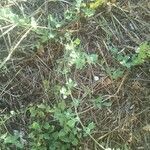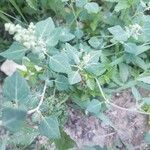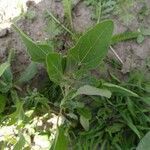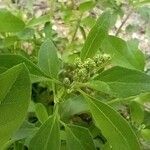Spreading annual, branching from base, with a strong fish-like smell. Leaves ovate to broadly ovate or trullate, entire, subglabrous above, mealy below; lamina 1–2 cm long; petiole slender, c. half length of lamina. Inflorescence of dense clusters of flowers forming compact axillary and terminal panicles 1–2 cm long. Flowers bisexual and female. Perianth subglobular, shortly 5-lobed, enlarging with and enveloping fruit, densely mealy. Stamens 5, glabrous, united into a cup-shaped disc at base. Pericarp membranous, papillose, somewhat adherent to seed. Seed horizontal, lenticular with obvious keel, 1–2 mm diam.; testa radially lineate.
Fetid annual, strongly white-mealy, erect or ascending, 1–5 dm, widely branched from the base; lvs broadly ovate, 1–3 cm and about as wide, entire, rounded or broadly cuneate to the petiole, densely white-mealy beneath, glabrescent above; infls few, of small glomerules in compact leafy spikes, chiefly from the upper axils; sep 5, white-mealy, rounded on the back; seeds horizontal, dull black, thick-lenticular, loose in the pericarp, 1 mm wide; 2n=18. Native of Eurasia, found here and there in our range as a weed.
An annual herb. It lies along the ground.










